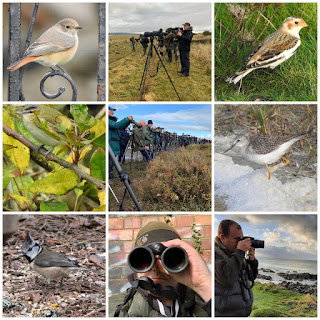The Covid pandemic has dominated the year for us all. We have all had to endure not seeing close family and adapt to new ways of working that are very often solitary. Two national lockdowns and the tiered system stopped some activity yet I was very grateful of a fantastic year with a couple of trips to north-east, Spurn and the Scillies. The lockdowns only really effected the start of the butterfly season and after that point I had some fantastic days in the sunshine. It has certainly helped having a wide range of interests when birding was limited. I really enjoyed the extra time around home researching the family tree of which I now have over 900 members, watching plenty of cricket at the club & on TV, and of course following the Saints. It seems that more people than ever are birding and taking an interest in nature.


It was a fantastic butterfly season thanks to some very favourable weather. I managed to record 53 species whilst my best find was a Clouded Yellow at Salford Priors. I have just four species left in the UK to see, fingers crossed we have the current travel restrictions lifted.
Salford Priors Gravel Pits Summary
Access remains very problematic yet I’ve still recorded over 400 hours on site this year, working from home and lockdown certainly gave me more time to visit early each day in spring & autumn. The land remains under lease to CEMEX and will do for another two years due to the slow speed of the restoration.
The water levels were too high during the spring, the lower levels in Autumn did help us record a number of passage wader species. High water levels prevented breeding of Oystercatcher, Shelduck, Lesser Black-backed Gull, Gadwall and Tufted Duck.
There was strong evidence that Common Redstarts & Wheatear both bred this year. Whilst no nests were observed very young juveniles were seen of both species. Other breeding successes included Cuckoo, Little Ringed Plover, Treecreeper, Sparrowhawk, Reed & Sedge Warbler. Two Turtle Dove was the maximum count of the year however we concluded that only one was a summer resident.
We recorded 143 species in the year, an increase of six from 2019. Highlights included the first record of Cattle Egret (in late November) and second records for White-fronted Goose, Knot, Nightingale and Wood Warbler. Other highlights included Arctic Tern, Black-tailed Godwit, Cetti’s Warbler, Garganey, Great White Egret, Marsh Harrier, Pink-footed Goose, Ruddy Duck, Spotted Flycatcher, Wood Warbler and Woodcock.
Many thanks to all those who contributed throughout the year and special recognition to Jon who continues to undertake monthly counts and offers much needed encouragement.
UK Life List
I observed fourteen new species in the year on my life list, which contained Caspian Tern, Long-tailed Skua & Icterine Warbler, all of which have been on my most wanted list for a number of years.
1) Scottish Crossbill (Scotland) January
2) Black Scoter (Northumberland) January
3) Caspain Tern (Norfolk) June
4) Greenish Warbler (Spurn, East Riding) June
5) Asian Desert Warbler (Northumberland) June
6) Icterine Warbler (Spurn, East Riding) August
7) Long-tailed Skua (Spurn, East Riding) September
8) Franklin’s Gull (West Yorkshire) September
9) Western Bonelli’s Warbler (Spurn, East Riding) October
10) Taiga Flycatcher (Befordshire) October
11) Brown Shrike (Northumberland) October
12) Rufous-tailed Scrub Robin (Norfolk) October
13) Indigo Bunting (St.Agnes, Scillies) October
14) Sociable Lapwing (Cornwall) December
* Bearded Vulture (Derbyshire) August
Many thanks to the Squire, Butterfly
Dave, Chris, the Captain, @1st Birdoftheday, the Scilly crew, Mark & Lloyd for their
company throughout the year.
My Birds of the Year
My favourite ten birds of the 250 I observed in 2020 based on the experience & location are the following :
1) Asian Desert Warbler - A cracking one day mega twitch to Holy Island, one of my favourite places.
2) Indigo Bunting - Right place, right time. Who says teachers week doesn't deliver anyone. The late ones are always the rarest ones.
3) Western Bonelli’s Warbler - When winds blow from the east Spurn is always worth a gamble. Impossible to have a bad days birding there.
4) Rufous-tailed Scrub Robin - The mega UK blocker came up as an alert as we closed in for Holy Island's Brown Shrike. We were never going to change direction and had a cracking day. I did go the next morning once reported out of duty more than anything.
5) Icterine Warbler - This species has been on my wanted list for years and some how this year I saw three! Spoilt for choice.
6) Sociable Lapwing - Two attempts made it all the sweeter. A genuine Christmas bonus.7) Brown Shrike - I missed a very showy Brown Shrike when on a weeks holiday in Devon so when this cracking bird game up on Holy Island a plan was quickly hatched.
8) Greenish Warbler - We earned this one with a walk to the tip of Spurn Point. We were rewarded with excellent views of the bird singing. 9) Collared Pratincole - A spring surpise down the M5. Who doesn't enjoy an amazing flying Pratincole.
10) Taiga Flycatcher - Part of the Autumn double. This little stunner showed perfectly before he headed further north for the Brown Shrike.
Merry Christmas, and a happy, healthy and bird-filled New Year!

















































